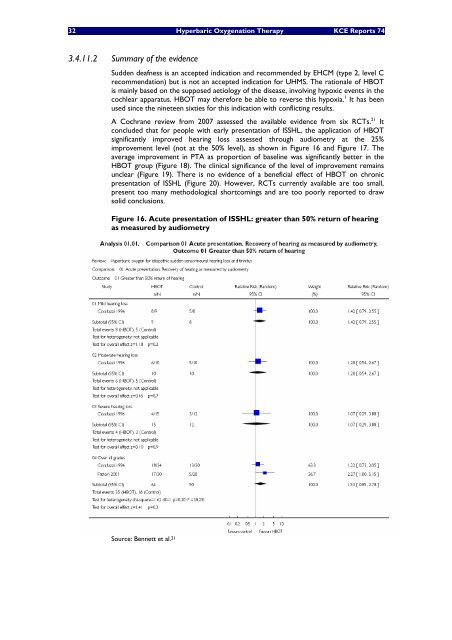Hyperbare Zuurstoftherapie: Rapid Assessment - KCE
Hyperbare Zuurstoftherapie: Rapid Assessment - KCE
Hyperbare Zuurstoftherapie: Rapid Assessment - KCE
You also want an ePaper? Increase the reach of your titles
YUMPU automatically turns print PDFs into web optimized ePapers that Google loves.
32 Hyperbaric Oxygenation Therapy <strong>KCE</strong> Reports 74<br />
3.4.11.2 Summary of the evidence<br />
Sudden deafness is an accepted indication and recommended by EHCM (type 2, level C<br />
recommendation) but is not an accepted indication for UHMS. The rationale of HBOT<br />
is mainly based on the supposed aetiology of the disease, involving hypoxic events in the<br />
cochlear apparatus. HBOT may therefore be able to reverse this hypoxia. 1 It has been<br />
used since the nineteen sixties for this indication with conflicting results.<br />
A Cochrane review from 2007 assessed the available evidence from six RCTs. 21 It<br />
concluded that for people with early presentation of ISSHL, the application of HBOT<br />
significantly improved hearing loss assessed through audiometry at the 25%<br />
improvement level (not at the 50% level), as shown in Figure 16 and Figure 17. The<br />
average improvement in PTA as proportion of baseline was significantly better in the<br />
HBOT group (Figure 18). The clinical significance of the level of improvement remains<br />
unclear (Figure 19). There is no evidence of a beneficial effect of HBOT on chronic<br />
presentation of ISSHL (Figure 20). However, RCTs currently available are too small,<br />
present too many methodological shortcomings and are too poorly reported to draw<br />
solid conclusions.<br />
Figure 16. Acute presentation of ISSHL: greater than 50% return of hearing<br />
as measured by audiometry<br />
Source: Bennett et al. 21

















